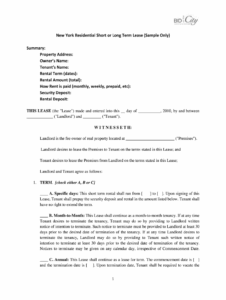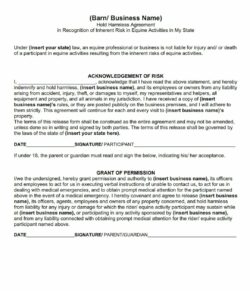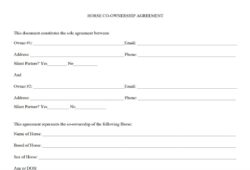So, you’re thinking about a horse half lease agreement template, huh? Maybe you’re a horse owner who could use some help with expenses and care, or perhaps you’re a rider who dreams of having more time in the saddle without the full responsibility of ownership. Either way, you’ve landed in the right place. Navigating the world of equine agreements can feel a bit like trying to decipher ancient hieroglyphics, but don’t worry, we’re here to break it down for you.
A horse half lease agreement can be a fantastic solution for both horse owners and riders. It allows the owner to share the financial and physical burden of horse ownership, while giving the lessee (the rider) increased access to a horse they can bond with and enjoy. It’s a win-win, right? Well, it can be, as long as everyone’s on the same page and everything is clearly outlined in a well-written agreement.
The key to a successful half lease is having a solid understanding of what both parties expect and what they are responsible for. This is where a good, comprehensive horse half lease agreement template comes in handy. It acts as a roadmap, preventing misunderstandings and setting clear boundaries from the get-go. Think of it as the prenuptial agreement for your equine partnership – not the most romantic thing, perhaps, but essential for a healthy and harmonious relationship. Let’s dive into the details of what makes a great agreement.
What Should Be Included in Your Horse Half Lease Agreement Template
Crafting the perfect horse half lease agreement template is like building a sturdy fence – it needs to be strong, well-defined, and clearly marked. A good agreement should cover all the essential aspects of the arrangement, leaving no room for ambiguity or misinterpretation. This not only protects both parties but also fosters a positive and trusting relationship between the owner and the lessee. Here’s a breakdown of some key elements you should consider including:
First and foremost, clearly identify all parties involved. This includes the full legal names and contact information of the horse owner (the lessor) and the rider (the lessee). You should also include a detailed description of the horse, including its registered name (if applicable), barn name, breed, age, color, markings, and any unique identifying characteristics. A picture of the horse can also be a helpful addition.
Next, outline the term of the lease. This specifies the start and end dates of the agreement. Will it be a six-month lease, a year-long lease, or something else entirely? Be clear about whether the lease is renewable and, if so, what the process for renewal entails. It’s also wise to include a clause that addresses early termination of the lease, outlining the conditions under which either party can terminate the agreement before the specified end date and what penalties, if any, might apply.
Financial considerations are crucial. Clearly state the amount of the lease fee, when it is due (e.g., monthly, quarterly), and the accepted methods of payment. In addition to the lease fee, specify how other expenses will be handled. Will the lessee be responsible for a portion of the board, farrier, veterinary care, or other costs? Be specific about what percentage of these expenses the lessee will cover and how those expenses will be documented and paid. A common arrangement is splitting expenses 50/50, but other arrangements are possible depending on the specifics of the situation.
Speaking of care, outline the usage of the horse. Detail the permitted uses of the horse, such as riding, showing, or trail riding. Specify any restrictions on use, such as limitations on jump height, the type of riding disciplines allowed, or whether the horse can be taken off the property. You should also address the care and maintenance of the horse. Who is responsible for grooming, tacking, and cooling down the horse after riding? Outline the feeding schedule and any specific dietary needs of the horse. It’s best to provide as much detail as possible to ensure the horse’s well-being.
Finally, address liability and insurance. Include a clause that releases the horse owner from liability for any injuries or damages sustained by the lessee while using the horse. It is also essential to determine who is responsible for insurance coverage. Will the horse owner maintain insurance, or will the lessee be required to obtain additional coverage? Discussing and clarifying these points can protect everyone involved and ensure peace of mind.
Adding Specificity to the Agreement
While the broader categories mentioned above are essential, consider adding more specific details tailored to your unique situation. For example, if the horse has any known health issues or behavioral quirks, be sure to disclose them in the agreement. This helps prevent misunderstandings and ensures that the lessee is aware of any potential challenges.
Essential Clauses for Your Horse Half Lease Agreement
Beyond the basic information and financial arrangements, certain clauses are essential to protect both parties in a horse half lease agreement template. These clauses address potential issues that may arise during the lease term and provide a clear framework for resolving disputes. They act as a safety net, preventing disagreements from escalating and ensuring that the lease arrangement remains fair and equitable.
A key clause to include is a termination clause. This clause outlines the conditions under which either party can terminate the lease agreement before the agreed-upon end date. It should specify the notice period required for termination and any penalties that may apply. For example, the clause might state that either party can terminate the lease with 30 days’ written notice, but that the lessee will forfeit any remaining lease fees if they terminate the agreement early. This protects the owner from losing income and gives the lessee time to find another horse if needed.
Another important clause is a dispute resolution clause. This clause outlines the process for resolving any disagreements that may arise between the owner and the lessee. It might specify that disputes must first be addressed through mediation or arbitration before resorting to legal action. Mediation involves a neutral third party who helps the parties reach a mutually agreeable solution, while arbitration involves a neutral third party who makes a binding decision on the dispute. Including a dispute resolution clause can help avoid costly and time-consuming litigation.
A clause regarding injury or death of the horse is also vital. This clause outlines the responsibilities of each party in the event that the horse is injured or dies during the lease term. It should specify who is responsible for covering veterinary expenses in the event of an injury and what happens if the horse dies. For example, the clause might state that the lessee is responsible for covering veterinary expenses up to a certain amount, and that the lease agreement will terminate automatically upon the horse’s death. This clause can help prevent emotional and financial hardship in the event of a tragedy.
It’s also wise to include a clause regarding amendments to the agreement. This clause specifies that any changes to the lease agreement must be made in writing and signed by both parties. This ensures that all parties are aware of any changes and that there is a clear record of the agreed-upon terms. Oral agreements or informal understandings can be difficult to enforce, so it’s important to put everything in writing.
Finally, a clause regarding governing law should be included. This clause specifies the state or jurisdiction whose laws will govern the interpretation and enforcement of the lease agreement. This is important because laws vary from state to state, and it ensures that the agreement will be interpreted according to the laws of the appropriate jurisdiction. It can also help avoid confusion and disputes if the parties reside in different states.
A horse half lease agreement can be a positive experience, granting you more saddle time or helping share the responsibility of horse ownership. When both parties feel secure and understood, the horse benefits most of all.
Creating a comprehensive document like a horse half lease agreement template may seem daunting, but the security and clarity it provides are invaluable, solidifying a smooth and enjoyable equine partnership.


